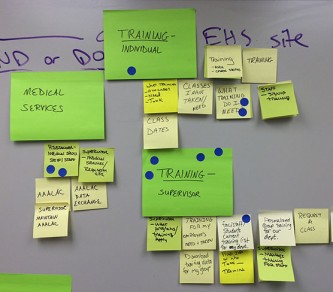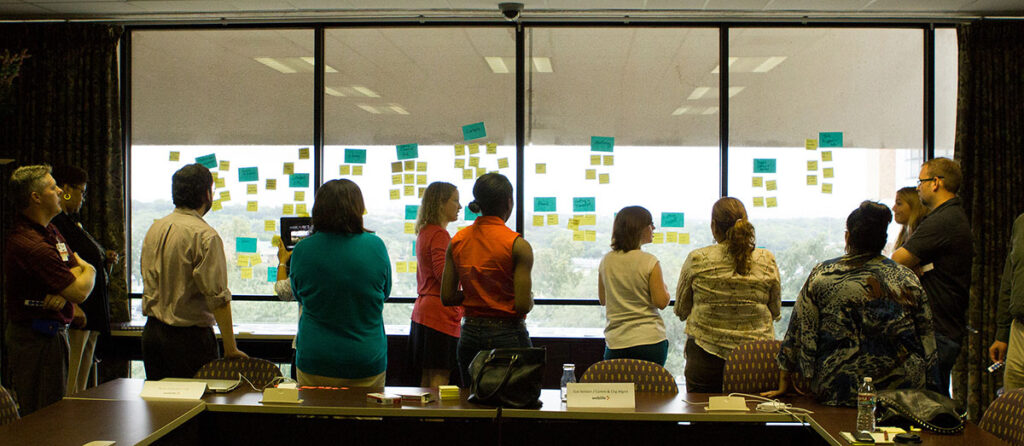
The KJ Method — created in the 1960s by Japanese anthropologist Jiro Kawakita — helps groups quickly reach consensus on organizing and prioritizing a set of ideas or data. It’s simple, easy to do, and cost-effective.
Why you should try it:
- Avoid distracting tangents and spend time on the things that get the most votes.
- Prevent one stronger personality from dominating the conversation.
- Get back to work in less than 90 minutes.
A KJ session can be run in-person or online. What works best for your organization?
For in-person meetings, stock up on:
- Sticky notes in 2 sizes. We use the standard small square notes for individual brainstorming and some larger ones for naming groups of sticky notes. You should have one pad of smaller notes per participant, although you can certainly split up a pad. You should also consider whether you want them to be all the same color or not. Sometimes we use colors to differentiate answers to different types of questions.
- Sharpie markers or similar. Do not use pens or pencils. The writing needs to be readable from at least 2 yards/meters from the wall.
- Small dot or star stickers that can be used for votes.
For virtual sessions, a great setup starts with:
- Using your favorite virtual whiteboard. We’ve used Miro.
- Creating areas on the board for each person to put their initial sticky notes, before moving them into a shared area for grouping and organizing them.
- Putting example sticky notes on the board ahead of time, so you don’t end up with wildly varying sticky note sizes.
- Encouraging everyone to use the same font size that’s still readable when you zoom out to see the whole board.
- Showing people how to turn off the feature that shows everyone else’s cursor location on the virtual board. That can be very distracting.
When you’re ready to start your session:
Your session should reflect four major activities: answering a focus question, identifying groups and patterns, voting on priorities, and review. Make sure that everyone has had time to review any related information to ensure informed and constructive participation.
With everyone ready to go, it’s time to establish the first rule of a KJ Session: NO. TALKING. At least not yet. This helps everyone feel welcome and able to share their answers.
- Ask a focus question (Examples: “What would a [specific audience] come to your website to find or do?” or “What one thing could we do that would most improve our visitor experience next year?”).
- Have each participant write answers to the focus question on sticky notes. They can add as many answers as they want, but each should be on its own sticky note. We usually give a time limit of 5-7 minutes for this step.
- Have everyone put their sticky notes on the wall in a random blob.
- Review answers for related patterns or similarities.
- Ask everyone to read the notes on the board. If they see two notes that are related/similar, move them into a group together.
- If two notes say exactly the same thing, put them on top of each other. You might need to help a bit with this by asking questions about why certain things were put together or by combining smaller groups. 20 groups is probably too many, for example.
- You should see some groups/patterns emerging. It’s OK if there are a couple of outliers, but if there are a lot ask the participants to try to find a home for the orphans.
- Discuss and come up with a name for each group. We will usually start at one end of the board and discuss each group.
- Vote for the most important groups.
- Give each person 6 dot or star stickers for voting. You may vary this number depending on your goals.
- They can put vote stickers on a the group label, or on an individual sticky note within the group. A vote for an individual sticky note puts emphasis on that one, but still counts as a vote for the whole group. They can put multiple votes on the same group.
- Review and discuss the top ranked items.
Learn more about the KJ Session technique (from UIE) and affinity diagrams (Wikipedia).

